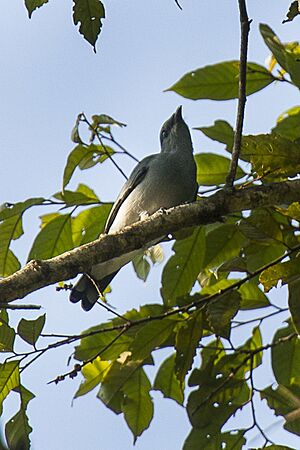Black-bibbed cicadabird facts for kids
Quick facts for kids Black-bibbed cicadabird |
|
|---|---|
 |
|
| Conservation status | |
| Scientific classification | |
| Genus: |
Edolisoma
|
| Species: |
mindanense
|
| Synonyms | |
|
Coracina mindanensis |
|
The black-bibbed cicadabird or black-bibbed cuckooshrike (Edolisoma mindanense) is a special kind of bird. It belongs to the Campephagidae family. This bird lives only in the Philippines, meaning it is endemic there. It's quite hard to spot and scientists don't know a lot about it.
This cicadabird usually lives in tropical moist lowland forests. Sadly, its home is disappearing because of habitat loss.
Discover the Black-bibbed Cicadabird
This bird is a medium-sized forest dweller. It lives in lowland and foothill forests. Its back and crown are gray. The edges of its wings are black, and its tail is black with white corners.
Male and female cicadabirds look different. This is called being sexually dimorphic.
- Males have a black forehead, face, and chest. This black area looks like a "bib."
- Females have gray underparts. Their "bibs" can be gray or white, depending on their specific group.
Some groups of these birds, especially those in the southern Philippines, have lighter bellies. The female black-bibbed cicadabird looks a bit like the female Blackish cuckooshrike. However, the black-bibbed one has a stronger bill and a lighter belly.
You might hear this bird make a sharp "wek!" sound. It also makes a whistle that goes down in pitch, repeated often. These birds are often seen alone or with other bird species in flocks.
Black-bibbed Cicadabird Family Members
Scientists recognize five different groups, or subspecies, of the black-bibbed cicadabird. Each group lives in a different part of the Philippines:
- Edolisoma mindanense mindanense: You can find this group on the islands of Mindanao and Basilan.
- Edolisoma mindanense lecroyae: This group lives on the island of Luzon.
- Edolisoma mindanense ripleyi: This group is found on Samar, Leyte, Bohol, and Biliran islands.
- Edolisoma mindanense elusum: This group makes its home on Mindoro island.
- Edolisoma mindanense everetti: This group lives on Jolo, Tawi-Tawi, and other islands in the Sulu Archipelago.
Protecting the Black-bibbed Cicadabird
The black-bibbed cicadabird lives in tropical moist lowland primary forest (old-growth forests) and secondary forest (forests that have regrown). They can be found up to 1,000 meters (about 3,280 feet) above sea level.
The IUCN Red List is a list that shows how much animals are at risk. They have listed this bird as vulnerable. This means it faces a high risk of becoming extinct in the wild. Experts believe there are only about 2,500 to 9,999 adult birds left.
The biggest danger to these birds is that their forest homes are being cut down. This is happening on all the islands where they live. Many lowland forests are not protected. This leaves them open to:
- Illegal logging: Trees are cut down without permission.
- Conversion into farmlands: Forests are cleared to make space for farms, often using Slash-and-burn methods.
- Mining: Land is dug up to find minerals.
Because these birds prefer lower altitudes, they have likely lost many of their homes as lowland forests in the Philippines disappear.
To help protect these birds, scientists suggest a few things:
- Do more surveys to find out exactly where they live and how many there are.
- Improve protection in areas that are already set aside for wildlife.
- Formally protect other important forest areas where these birds live.


